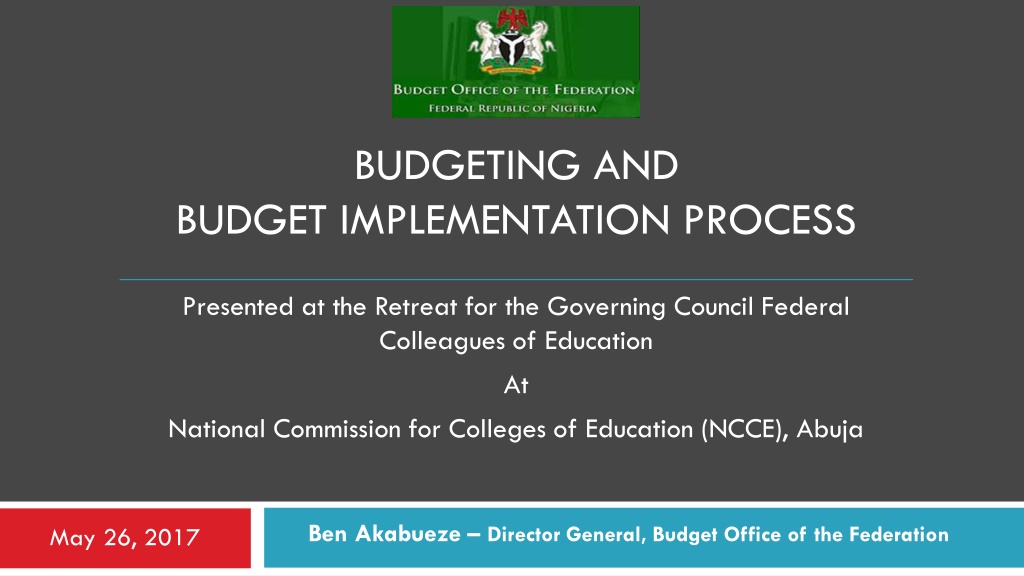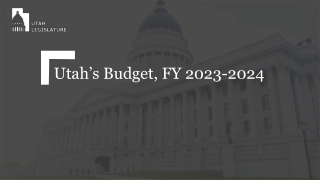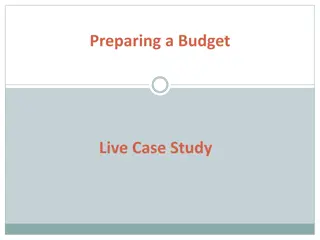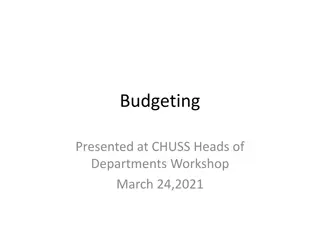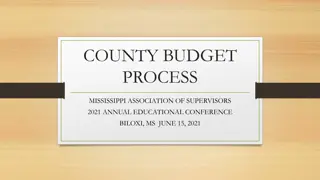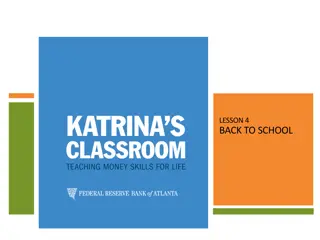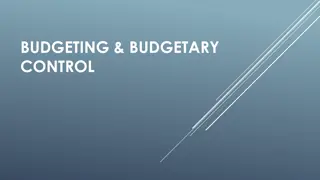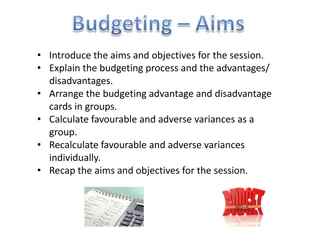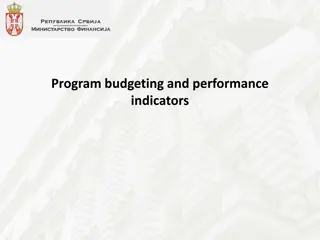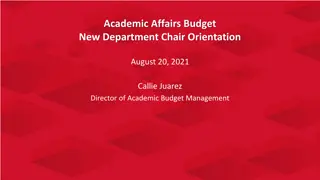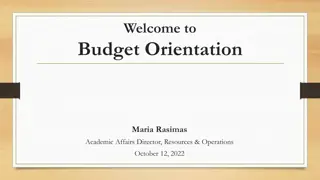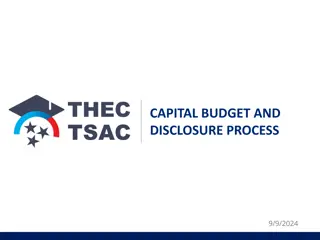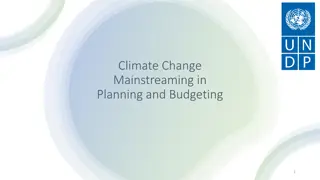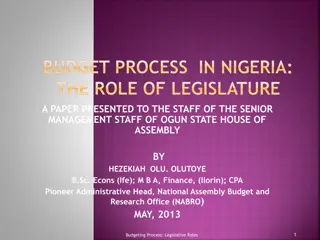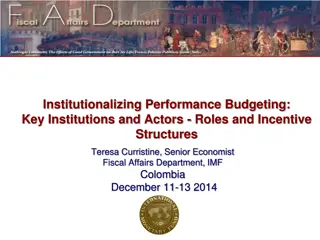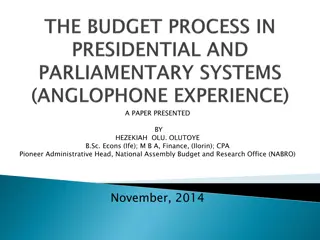Understanding Budgeting and Budget Implementation Process in Government
This presentation delves into the concepts of budgeting and budget implementation in the context of government finance, focusing on fiscal policies, macroeconomic goals, and the budget framework. It explains how budgets reflect government priorities and strategies to achieve economic stability and growth through expenditure plans, taxation, and monetary policies. The discussion also covers fiscal strategies such as stabilizing the macroeconomic environment, promoting agriculture and food security, enhancing energy and transportation infrastructure, and driving industrialization. Overall, it provides insights into the key considerations and challenges of budgeting in the public sector.
Download Presentation

Please find below an Image/Link to download the presentation.
The content on the website is provided AS IS for your information and personal use only. It may not be sold, licensed, or shared on other websites without obtaining consent from the author. Download presentation by click this link. If you encounter any issues during the download, it is possible that the publisher has removed the file from their server.
E N D
Presentation Transcript
BUDGETING AND BUDGET IMPLEMENTATION PROCESS Presented at the Retreat for the Governing Council Federal Colleagues of Education At National Commission for Colleges of Education (NCCE), Abuja Ben Akabueze Director General, Budget Office of the Federation May 26, 2017
Outline 2 Section I The Concept of Budget and Budgeting Section II Budget Implementation Process Introduction Budget Implementation beyond Expenditures Understanding the Concepts of Budget and Budgeting Components of Budget Implementation System Why and How should we Budget? Budget Implementation: Issues What Makes a Good Budget? Budget Implementation: Addressing the Issues The Process of Budgeting Key Considerations in Budgeting Budget Implementation: What s New? The Budget Framework
Section I UNDERSTANDING THE CONCEPTS OF BUDGET AND BUDGETING
Understanding the Concepts of Budget and Budgeting 4 Budget A budget is not just a set of revenue & expenditure plans by the Government, but a statement of its fiscal policies and related policies which are intended to achieve macroeconomic goals Government spending & taxation to influence the economy Fiscal Policy Adjusting Money Supply (MS) through interest rate to achieve a combination of inflation and output growth Monetary Policy Related Policies Aims to balance a country s exports & imports by changing the relative prices of foreign and domestic goods for the country s residents Exchange Rate Policy
Understanding the Concepts of Budget and Budgeting /2 5 FISCAL STRATEGY Some macroeconomic goals Stabilize the macroeconomic environment Achieve agriculture and food security Expand energy infrastructure and capabilities Improving transportation infrastructure Drive industrialization through local and small business enterprise Plan A Expansionary fiscal policy? Increase spending, increase transfers or reduce taxes Financing the increased spending Raising taxes & other revenues Operating surpluses of GOEs Borrowing BUDGET
Understanding the Concepts of Budget and Budgeting /3 6 FISCAL STRATEGY Some macroeconomic goals Stabilize the macroeconomic environment Achieve agriculture and food security Expand energy infrastructure and capabilities Improving transportation infrastructure Drive industrialization through local and small business enterprise Plan B Contractionary fiscal policy or fiscal consolidation? Cut spending (austerity), reduce transfers or increase taxes How do we define prudent fiscal management? BUDGET
Understanding the Concepts of Budget and Budgeting /4 7 Government development agenda vis- -vis the economic situation gives direction to annual budgeting BUDGETING The choice among competing alternatives! Objective ought to be to achieve the most desirable allocation of funds among alternative uses The art of crafting a budget to achieve set developmental goals
Why and How should we Budget? 8 Why Budget? Resource constraints vs. competing economic needs Common Pool theory Techniques Incremental Zero-Base Line-item Performance-Based Budgeting If resources were limitless will there still be need to budget? YES! the priority placed on expenditure items and the sequencing of spending may vary Irrespective of the preferred option/technique of budgeting, budgets are still based on some limits Budget is principal tool for implementation of fiscal policy
What Makes a Good Budget 9 Use of limits to control major expenditure heads Defining the rules of the game upfront Overall objectives Expenditure limits/ceilings Deadlines Timetables Roles and Responsibilities Conservative revenue projections based on prudent assumptions Oil price assumptions Oil production assumptions Exchange rate Major expenditure heads Aggregate spending MDA expenditure MDA sub-limits Clear practical sources of financing fiscal deficit Source of funding borrowing, financing items Plan to generate funding from each source
What Makes a Good Budget.../2 10 Linkage with the priorities of the government and her strategy Bulk of spending must be on priority sectors Spending must be consistent with fiscal strategy Spending must be consistent with strategy for each priority sector Transparency / Stakeholder engagement MDAs Civil society Private Sector Household segments Legislature Ordinary Citizens Timeliness Clear, credible timetable Compliance with timetable Confidence in the budget process That rules will be enforced That timetable will be kept to That budget can and will be funded
The Process of Budgeting 11 Budgeting entails a number of activities performed in order to prepare a budget. 1. Medium-Term Revenue Framework Budget Call- Circular, and Budget proposal submission by MDAs 6. Budget Monitoring & Evaluation 2. Medium-Term Fiscal Framework Transmission, consideration and bilateral discussions 3. Medium-Term Sector Strategies & Rapid Appriasal 5. Budget Preparation, Presentation & Appropriation 4. Formal MTEF/FSP Approval / Appropriation
Key Considerations in Budgeting 12 The economic context usually influenced by: Global economic environment Domestic macro-environment Government s development priorities Vision 20:2020; Transformation Agenda; SIP; ERGP Macroeconomic Framework: assumptions and projections Sustainability of deficit and debt Economic and Social benefits @ what cost?
Key Considerations in Budgeting /2 13 GLOBAL DEVELOPMENTS What demand and growth? What is happening to oil price? Are supply-side responding for price decline or demand or both? How are global demand shocks and oil price affecting movements in exchange rates? What about activities in major economies like macroeconomic realignments in China to a new growth model BREXIT U.S interest rate adjustments DOMESTIC DEVELOPMENTS Insurgency & Insecurities Crude oil theft and pipeline vandalism Infrastructure deficit Foreign Exchange (FX) scarcity and Exchange rate tension Rising Unemployment Contraction in growth is happening to global factors mainly The external factors creates spillovers to domestic environment through trade, exchange rates, asset markets, and capital flows.
The Budget Framework 14 Fiscal Balance Aggregate Expenditure Revenue Non-Oil Oil Capital Recurrent Deficit Surplus Tax and Non-Tax Revenues Balanced Crude oil sales Royalties Recurrent Debt Recurrent Non-Debt Borrowing Sale of Govt. Property Privatization Proceeds Recoveries
Section II BUDGET IMPLEMENTATION PROCESS
Budget Implementation: ...beyond Expenditure 16 Budget is beyond Expenditure Plans! Implementation starts with Revenue Deficit levels & Borrowing space matters At first level, implementation of expenditure plans depends on revenue outturns and much we can borrow
Budget Implementation: ...beyond Expenditure/2 17 Revenue outturns have been less than projections Partly a reflection of ambitious revenue projections Crude oil theft and pipeline vandalism Collection inefficiency Insecurity in some parts of the North affecting economic activities and tax collection FGN'S REVENUE PERFORMANCE, N'BILLION (2012-2016) 5,000.00 4,000.00 3,000.00 2,000.00 1,000.00 0.00 2012 2013 2014 2015 2016 Budget Actual Lower-than-projected revenue outturns undermine budget implementation
Components of Budget Implementation System 18 Expenditure Plans Release of funds: Quarterly release vs. Project-based releases Cash and debt management Procurement Control and monitoring of expenditure In-year implementation reports
Budget Implementation Process: Issues 19 Revenue shortfalls Implementation systems may reflect lack of incentives for good budget implementation, rather than lack of capacity Incentives for compliance or non-compliance institutional issues are important, not just technical fixes Poor system of commitment control Expenditure arrears Undermining Budget priorities
Budget Implementation Process: Issues /2 20 Personnel costs represent a very significant proportion of the FGN s budget expenditures Very high wage bill due to huge increases starting in 2009 In 2009, the total wage bill was N857 billion; now it s N1.87 trillion Due to pressures for wage and pension (military and civilian) increases, and Ghost workers (especially in agencies yet to be included in the IPPIS)
Budget Implementation Process: Issues /3 21 TREND IN THE WAGE BILL (2006-2017B) 2,500 45% Until 2016, Personnel cost exceeded capital budget 40% 2,000 35% Personnel Cost (% of FGN Budget) 30% Amount (N'bns) 1,500 25% 20% 1,000 15% 10% 500 Personnel cost is still high and rising despite enhanced capital:recurrent expenditure mix 5% - 0% 2006 2007 2008 2009 2010 2011 2012 2013 2014 2015 2016 2017 Personnel Capital Personnel as % of FGN Exp. [RHS]
Budget Implementation Process: Addressing the Issues 22 Linking Budget to a Plan and developing an clear implementation Plan Nigeria s ERGP Nigeria s Economic Recovery and Growth Plan Objectives: Prioritize key turnaround interventions and enablers in order to generate concrete, visible impact by end of 2017 Strategic Implementation Plan 2016 Objective: outline priority actions to put the economy on a path of sustainable and inclusive growth
Budget Implementation Process: Addressing the Issues /2 23 Budget realism/credibility: Actualizing revenue projections Free up resources for capital budget implementation by ensuring greater efficiency in the management of personnel costs, including elimination of all ghost workers from payroll All Government Staff must be enrolled on IPPIS Releases for payment of salary, allowances and pension arrears must be requested separately, with relevant justification and attachments provided No MDA is allowed to take any action that may result in increase in its personnel cost without the due processes for approval of such action Predictabilility and timeliness in release of funds to allow for orderly planning and implementation by spending ministries.
Budget Implementation Process: Addressing the Issues /3 24 Priority ranking of the project among the MDA s approval projects Targeted release of funds: Project-based releases The erstwhile procedure for quarterly releases of appropriated Capital Expenditure votes have been discontinued. The Cash Management Committee approves specific capital releases periodically based availability of funds, government priorities as well as the M&E reports on projects/programmes State the uncommitted funds, available budget balance against which the request is to be charged Provide evidence of compliance with the Bureau of Public Procurement procedures
Budget Implementation Process: Whats New? 25 Provisions for payment of utility bills incurred by MDAs are included in their respective Overhead Budgets No MDA is authorized to enter into a contract denominated in any foreign currency without the prior approvals of the HM-BNP and HMF MDAs are to ensure that their contracts are wholly denominated in Naira Efficiency Unit charged with reviewing government expenditures with a view to identifying areas where wastage can be curtailed and efficiencies enhanced Strengthened Monitoring and Evaluation Framework This will cover physical inspection/verification as well as Impact Assessment of projects/programme implemented by MDAs
